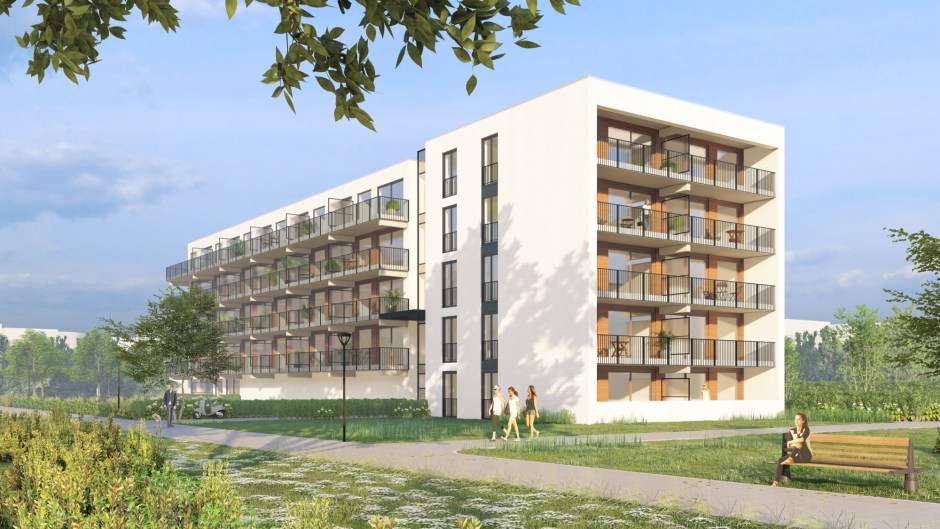Housing Markets Post-COVID-19: Challenges for the Dutch Housing System
Editie: 28 - CRISES
Published on: 15 maart 2021
The COVID-19 pandemic has challenged many of our everyday realities. One year after the first lockdowns were put in place in Europe, we struggle to make sense of its impact on different social domains, and the real estate market is no different. What will be the long-term effects of the COVID-19 pandemic on the housing market, office market or other types of commercial/industrial real estate? When and how will the expected economic crisis affect these sectors? What we know now is that whatever challenges we were facing before COVID-19, they will likely be exacerbated by the pandemic and ensuing crises. This is especially the case when it comes to the housing market.

Housing crisis before COVID-19
So, what were the main challenges of the housing system and the housing market in the Netherlands before COVID-19? Broadly speaking, these would be housing shortage, unaffordability, and growing inequalities transmitted through one’s housing position (Arundel and Lennartz, 2020). Back in 2018, it was estimated that the housing shortage was between 100.000 and 140.000 houses (Lennartz, 2018), with large cities in the Randstad experiencing particularly high housing shortages. A report of the CBS and PBL (De Jong et al, 2019) projected the housing shortage to grow until 2025, after which it should decline. At the start of the COVID-19 pandemic, the shortage was already estimated at about 300.000 dwellings. Particularly large cities will see the most severe effects of the housing shortage, among them growing house prices and rent, and accompanying accessibility and affordability problems especially for vulnerable social groups (low-income starters, students, status holders, lone elderly).
The financialized housing system has engendered profound inequalities, unaffordability and shortage on the housing market
Tenure change over the last few decades, including expanding homeownership, a shrinking social housing sector, and, after 2014, a growing private rental sector puts the affordability crisis into perspective. The financialized system that allowed easy access to credit leading up to the 2008-2009 global financial crisis, enabled many to join the ranks of mortgaged homeowners. In the wake of the financial crisis the Dutch household mortgage debt exceeded GDP, the highest level in Europe. Credit constraints since the crisis have affected primarily people trying to enter the homeownership market, while the low interest rate regime has made it easier for people who already own property and other assets to purchase more properties. This last development is reflected in the growth of the buy-to-let market in the last five years (Aalbers, Hochstench and Bosma, 2020), especially in mid-size and student cities in the Netherlands. Mirroring this development is an increasingly powerful public outcry for young starters who find it difficult to purchase homes or even launch independent housing careers.
COVID-19 will exacerbate the housing crisis
Social inequalities between those that have a solid position on the housing market (e.g. outright owners, investors) and those that are trying to get onto the housing market (e.g. first-time buyers) have exacerbated. Similarly, spatial inequalities between those that can afford to enter overheated markets (e.g. the Randstad) and those that cannot have increased, in a process called the suburbanization of poverty (Hochstenbach and Musterd, 2018). In popular cities, higher rents are paid for smaller and smaller places. Young people have especially been affected by growing rents and unaffordable homeownership, with co-residence with parents on the rise. As the social housing sector has become unable to provide the necessary safety net for many vulnerable groups in society, we’ve seen a growth in homelessness – from roughly 10,000 people in 2009 to close to 40,000 people by 2018 – and especially youth homelessness – from 4,000 people to more than 12,000 people in the same period (CBS, 2019).
Government response to the housing crisis was slow. Tackling the housing shortage came high on the agenda after 2018, with Woondeals (Housing Agreements) stipulating ambitious goals for housing production (BZK, 2020). However, progress on these goals has stalled, and the building quotas have consistently not been met in recent years. Realigning housing, environmental and social care agendas has also been an important priority, with the big push for the energy transition in the built environment happening at the same time as the social care system reform (Druta, Schilder and Lennartz, forthcoming). In 2019, a stimulus package was put in place for the building of flexible and temporary housing (flexwonen) to cater to the immediate needs of social groups considered to be ‘emergency seekers of housing’ (Stimuleeringsaanpak Flexwonen, 2019). The effects of this policy in increasing the resilience and flexibility of the seniority-based social housing allocation system are still to be seen. A realization that there is in fact a housing crisis coincided with the breakout of COVID-19, leading to discussions in political circles about the desirability of a ministry dedicated to sorting out the housing system. The upcoming elections will see housing as one of the main topics on the agenda for many political parties.
Housing markets during and after COVID-19
What have been the effects of the COVID-19 pandemic and what will be its likely impacts in the mid-term? Worldwide, immediate government measures to contain the spread of COVID-19 fundamentally challenged the ways we value and give meaning to home and housing (Gurney, 2020). As the effects of lockdown measures became clearer throughout 2020, public discourse soon changed from ‘we are all in the same boat’ to a painful realization that social inequalities were exacerbated by measures concentrated on self-isolation at home. Nowhere was this more evident than in the housing field, as indicated by calls to action of the UN Rapporteur for the Right to Housing to improve housing conditions for homeless individuals, those living in refugee camps and other informal settlements, and in precarious housing situations (Farha, 2020). Bans of evictions were put in place in many countries, including the Netherlands (BZK), to prevent renters from losing their homes, especially in the private rental sector. Mortgage and rent support were implemented in many countries as part of government household support packages at the beginning of the pandemic.
A profound reconsideration of the value of housing is necessary to reorient the housing system
The effects of COVID-19 hit home (pun intended), and they are likely to continue to be felt acutely in the sphere of the home for the years to come. Since initial confined measures were initially imposed, the home has become the site of everything, not just leisure and personal/family care, but also working-from-home (WFH), education at home (from primary school until university), and more. Some of these home activities will likely be temporary adaptations, while others are likely to have persisting effects in the years ahead. WFH is a case in point. While many people find the lack of office social life difficult and miss the dynamic interaction of teams meeting in real life, surveys suggest that people are generally positive about working from home and many would welcome working from home after the pandemic as well (Agteren, 2020). This will have a profound impact not only on how we organize home life, but also on how we make decisions about residential mobility. In dynamic housing markets, signs of a flight from urban centers are already evident (Haag, 2020), prompting further concerns about the polarization of housing markets. Incidentally, office life will likely also be reorganized, with more emphasis put on the social character of office spaces, and perhaps a reorientation towards more flexible co-working spaces fit for working at a distance close to home.
On the housing market, the expectation of house prices and demand for housing decreasing due to the economic insecurity accompanying the pandemic was not borne out. Predictions of house-price decline in the Netherlands were proven wrong, and the anxiety from the beginning of the March-April lockdown (Groot & Spiegelaar, 2020) turned into optimism by May (Graaf, 2020) and a more cautious prediction of housing market slump for the beginning of 2021 (Spiegelaar, 2020). So far, these predictions have also not reflected developments, with house prices in January 2021 at an all-time high especially in large cities. The acute housing shortage is seen as the primary reason for continued high demand which, coupled with low interest rates and few alternatives to buying, incentivize people to keep taking on mortgages. Nevertheless, the decoupling between the housing market and the wider economy will likely be remedied throughout 2021 (Groot and Vrieselaar, 2020)
Leadership for a well-being and sustainability supporting housing system
The need for affordable and adequate housing will likely increase in the years ahead, as more people feel the impact of economic insecurity. Making sure that the building and investment effort addresses changing aspirations and life courses will require a participatory process that takes stock of the problems and reengages governments, housing providers, citizens, developers, builders, operators and investors. Socially provided housing in the post-COVID-19 era will be vital for the security and wellbeing of an increasingly diverse constituency. Therefore, investments in this sector will be of the utmost priority for the recovery period. Better regulation of both the homeownership and the private rental market should follow. Housing markets need to be reorganized, and the fundamental values for an equitable and sustainable housing system redefined. The leadership role of governments cannot be overstated.
The common saying goes that we should never waste a good crisis. Still, the 2008-2009 financial crisis has proven we are very much capable of doing just that, judging by the deepening financialization and growing inequalities of the last decade. To seize the opportunity of the COVID-19 crisis, housing must become a human right (Farha, 2020, European Parliament, 2021), and we as a society must embark on a journey of the imagination, to put together social and technical innovations, traditional and alternative tenures, ways of living together, policies, housing provision and consumption practices into resilient housing systems.
References:
Aalbers, M., Hochstenbach, C., Bosma, J., & Fernandez, R. (2020). The death and life of private landlordism: How financialized homeownership gave birth to the buy-to-let market. Housing, Theory and Society, 1-23.
Agteren, R (2020) Helft van de Nederlanders wil ook blijven thuiswerken na Corona; https://www.ad.nl/werk/onderzoek-helft-van-de-nederlanders-wil-ook-blijven-thuiswerken-na-corona~a6e9bb92/?referrer=https://www.google.com/
Arundel, R., & Lennartz, C. (2020). Housing market dualization: linking insider–outsider divides in employment and housing outcomes. Housing Studies, 35(8), 1390-1414.
Druta, O., Schilder, F., & Lennartz, C. (forthcoming) Home investments in later life: Competing policy goals and the practices of older Dutch homeowners.
European Parliament (2021) Resolution on Access to Decent and Affordable Housing for All, https://www.europarl.europa.eu/doceo/document/A-9-2020-0247_EN.html
Farha, L., Johal, A., Smith, P., Roach, M., Feng, K., & Pinillos, F. (2020). The Human Right to Housing—with Leilani Farha.
Graaf, S. van de (2020). Woningmarkt woord steeds gezonder, Dutch Realtors Association, retrieved from: https://www.nvm.nl/nieuws/2020/woningmarkt-wordt-gezonder/
Groot, C. de , & Spiegelaar, L. (2020). Ook de huizenmarkt is niet imuun voor her coronavirus, Rabo Research, March Theme Issue, retrieved from: https://economie.rabobank.com/publicaties/2020/maart/ook-de-huizenmarkt-is-niet-immuun-voor-het-coronavirus/
Groot, C. De & Vrieselaar, N (2020) Waarom de woningmarkt doordendert ondanks Corona; https://economie.rabobank.com/publicaties/2020/oktober/waarom-de-woningmarkt-doordendert-ondanks-corona/
Haag, M. (2020). New Yorkers are fleeing to the suburbs. New York Times, retrieved from: https://www.nytimes.com/2020/08/30/nyregion/nyc-suburbs-housing-demand.html
Hochstenbach, C., & Musterd, S. (2018). Gentrification and the suburbanization of poverty: Changing urban geographies through boom and bust periods. Urban Geography, 39(1), 26-53.
Hochstenbach, C. (2020). De wooncrisis woord nog steeds pijnlijker door corona, retrieved from https://www.rtlnieuws.nl/economie/opinie/column/5065636/coronavirus-woningnood-woningmarkt
Jong, A. de, Huisman, C., and Stoeldrijer, L. (2019) Regionale bevolkings en huishoudensprognose 2019-2050, retrieved from: https://www.pbl.nl/publicaties/pbl-cbs-regionale-bevolkings-en-huishoudensprognose-2019-2050-belangrijkste-uitkomsten
Lennartz, C (2018) Thema Bericht Rabo Research, retrieved from: https://economie.rabobank.com/publicaties/2018/juni/de-omvang-en-prognoses-van-het-woningtekort/
CBS (2019) Aanal daklozen sinds 2009 meer dan verdubbeld, retrieved from: https://www.cbs.nl/nl-nl/nieuws/2019/34/aantal-daklozen-sinds-2009-meer-dan-verdubbeld
Spiegelaar, L. (2020). Tijdelijke dip in huisprijzen en woningverkoop verwacht vanaf 2021, Rabo Research, September Quarterly Brief, retrieved from: https://economie.rabobank.com/publicaties/2020/september/tijdelijke-dip-in-huizenprijzen-en-woningverkopen-verwacht-vanaf-2021/#9575ef0b-50d7-4df5-9da5-18439d9f65da
Mail the editors